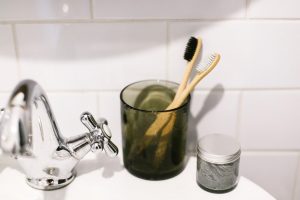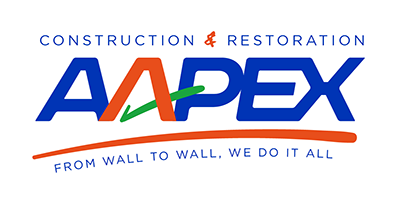With more than 1,000,000 species spread across all seven continents of the world, mold can be found everywhere. Most of these mold species are perfectly harmless. However, those that take up residence inside can cause significant health problems (not to mention damage to your home). According to the CDC, mold exposure can cause a whole host of health issues including skin irritation, respiratory issues, and red or itchy eyes. For children and people with underlying health issues, mold exposure has been linked to the development of asthma and much more severe reactions, including fever and shortness of breath. For these reasons, it’s important to be vigilant about any mold you find in your home. While large mold colonies are fairly easy to find, you may be surprised at the places mold often lurks inside your home. Here are nine of the most common places mold hides.
Under the Sink
 Warm, moist, dark environments offer the ideal conditions for mold growth. Any place away from the sun that has the potential to collect water in your home should be regularly checked for mold growth. One of the most prominent places for this is under your kitchen and bathroom sinks. Moisture from plumbing leaks or even condensation on the pipes or underside of the basin will often go undetected. Be sure to keep these areas dry and tidy and repair any leaks as soon as you notice them. Periodically wiping down the area underneath your sinks with a 1:8 bleach-water solution will keep it clean and prevent any mold growth from spreading.
Warm, moist, dark environments offer the ideal conditions for mold growth. Any place away from the sun that has the potential to collect water in your home should be regularly checked for mold growth. One of the most prominent places for this is under your kitchen and bathroom sinks. Moisture from plumbing leaks or even condensation on the pipes or underside of the basin will often go undetected. Be sure to keep these areas dry and tidy and repair any leaks as soon as you notice them. Periodically wiping down the area underneath your sinks with a 1:8 bleach-water solution will keep it clean and prevent any mold growth from spreading.
Behind Wallpaper or Drywall
People often expect mold to appear on the surface of walls, but what they often don’t realize is that mold also enjoys the dark recesses behind your walls. Drywall and wallpaper are both composed of materials that mold love to eat. If there is excess moisture in a room, don’t be fooled into thinking the room is mold free just because you don’t see it. Very often, mold will grow on the backside of wallpaper and drywall. Regularly wiping down your walls with a vinegar or bleach solution will help impede mold growth. Be sure to run a dehumidifier in any room where humidity levels rise above 55%.
On or Inside Appliances
 Dishwashers, washing machines, refrigerators, and coffee makers are all susceptible to mold growth. Moisture accumulates in coils, seals, and drip pans, and unless regularly cleaned out and left dry, mold will be able take hold. This is particularly troublesome for front-loading washing machines, which need to be left open and cleaned to prevent mold from growing in the seals. Dishwashers and washing machines should be run empty once a week, with ½ cup of distilled white vinegar or lemon juice. Periodically clean refrigerator seals, shelves, and drawers with distilled white vinegar or a baking soda solution. Run your coffee maker with a solution of equal parts water and distilled white vinegar and be sure to empty your grounds and wipe down the inside of your machine as soon as you’re done with your morning cup.
Dishwashers, washing machines, refrigerators, and coffee makers are all susceptible to mold growth. Moisture accumulates in coils, seals, and drip pans, and unless regularly cleaned out and left dry, mold will be able take hold. This is particularly troublesome for front-loading washing machines, which need to be left open and cleaned to prevent mold from growing in the seals. Dishwashers and washing machines should be run empty once a week, with ½ cup of distilled white vinegar or lemon juice. Periodically clean refrigerator seals, shelves, and drawers with distilled white vinegar or a baking soda solution. Run your coffee maker with a solution of equal parts water and distilled white vinegar and be sure to empty your grounds and wipe down the inside of your machine as soon as you’re done with your morning cup.
Above Ceiling Tiles
Typically made from mineral wood, gypsum, cellulous or starch, ceiling tiles provide an excellent hiding place for mold. Often hung to conceal pipes and ductwork, the area above ceiling tiles tends to accumulate dust, moisture, and – you guessed it – mold. Warm, moist air circulating near the HVAC vents make these tiles particularly susceptible. Keep a keen eye out for apparent water damage on your ceiling tiles as well as the beginnings of mold growth. As always, run a dehumidifier in any room where moisture levels rise above 55% humidity to help prevent mold from growing on ceiling tiles.
On Your Dishes
 Emptying the dishwasher or emptying the dish drain are two of the most dreaded kitchen chores, second only to actually handwashing the dishes. But skipping the step of drying the dishes of any remaining water before stowing them in the cupboards may be giving mold an inviting place to thrive and dine. The underside of coffee mugs, food containers and their lids, even plates all need to be thoroughly dried before being put away.
Emptying the dishwasher or emptying the dish drain are two of the most dreaded kitchen chores, second only to actually handwashing the dishes. But skipping the step of drying the dishes of any remaining water before stowing them in the cupboards may be giving mold an inviting place to thrive and dine. The underside of coffee mugs, food containers and their lids, even plates all need to be thoroughly dried before being put away.
Under the Welcome Mat
 Welcome mats are great for giving guests to your home a designated place for stomping the mud, rain, and snow off their shoes before entering your home. Unfortunately, excelling at retaining moisture also makes mats a welcome home for mold. If your welcome mat sits in an area where it can be exposed to rain or snow, it will also act like a sponge, absorbing and holding onto as much precipitation as it can. To prevent your welcome mats from hosting a colony of mold, regularly rinse and hang them to dry, allowing the floor underneath to dry as well.
Welcome mats are great for giving guests to your home a designated place for stomping the mud, rain, and snow off their shoes before entering your home. Unfortunately, excelling at retaining moisture also makes mats a welcome home for mold. If your welcome mat sits in an area where it can be exposed to rain or snow, it will also act like a sponge, absorbing and holding onto as much precipitation as it can. To prevent your welcome mats from hosting a colony of mold, regularly rinse and hang them to dry, allowing the floor underneath to dry as well.
Inside the Toothbrush Holder
 Most people store their family’s toothbrushes in a container next to the sink. While this is certainly a convenient way to keep your counter organized, your toothbrush holder also provides the ideal environment for mold growth. After brushing, most people plant their toothbrush right back into the toothbrush holder, where the water from the bristles runs down the handle and collects in the bottom of the container. To prevent mold from growing here, regularly clean and dry your toothbrush holder. Encourage family members to rinse and dry their toothbrush on a towel before returning it to the holder.
Most people store their family’s toothbrushes in a container next to the sink. While this is certainly a convenient way to keep your counter organized, your toothbrush holder also provides the ideal environment for mold growth. After brushing, most people plant their toothbrush right back into the toothbrush holder, where the water from the bristles runs down the handle and collects in the bottom of the container. To prevent mold from growing here, regularly clean and dry your toothbrush holder. Encourage family members to rinse and dry their toothbrush on a towel before returning it to the holder.
Inside Paper Files
Most people never consider their filing cabinet and any stored paper as the ideal environment for mold to thrive, but it makes sense when you consider that paper is made from wood pulp. Files are often stored away in a dark desk drawer or Bankers Boxes stowed in the basement. Add high humidity, and you have the potential for mold growth. Once mold takes hold of any paper files, it is difficult to reverse the damage. Prevent your files from growing mold by being careful not to store them in damp areas. Bankers Boxes, while convenient, absorb and retain moisture. Consider storing old files in plastic, lidded totes. Run a dehumidifier in any room where the moisture levels are high enough to promote mold growth (anything higher than 55% humidity). For home offices in the basement, a dehumidifier is a must not only for preventing mold growth but also for protecting electronics from excess moisture.
Inside Potted Plants
 Mold thrive in dark, moist environments. Mold are particularly happy in environments rich with nutrients. In fact, mold are responsible for breaking down the vast majority of the world’s decomposing plants and plant waste. Given that, it’s not too surprising that mold would be really happy inside your home’s potted plants. Rich soil, regular watering, shade from the sun – it’s practically a mold’s dream home. Mold on potted plants will often appear as white patches in the soil or it may grow on the outside of the pot itself, particularly terra cotta pots. Scoop away any mold growth you notice on the surface of the soil and wipe down the outside of the pot with a vinegar solution. Only water indoor plants when the soil is dry and empty any water that runs out into a catch basin right away. Finally, sprinkle a natural anti-fungal, like cinnamon, baking soda, or apple cider vinegar, on your plant soil to prevent mold spores from spreading throughout the pot.
Mold thrive in dark, moist environments. Mold are particularly happy in environments rich with nutrients. In fact, mold are responsible for breaking down the vast majority of the world’s decomposing plants and plant waste. Given that, it’s not too surprising that mold would be really happy inside your home’s potted plants. Rich soil, regular watering, shade from the sun – it’s practically a mold’s dream home. Mold on potted plants will often appear as white patches in the soil or it may grow on the outside of the pot itself, particularly terra cotta pots. Scoop away any mold growth you notice on the surface of the soil and wipe down the outside of the pot with a vinegar solution. Only water indoor plants when the soil is dry and empty any water that runs out into a catch basin right away. Finally, sprinkle a natural anti-fungal, like cinnamon, baking soda, or apple cider vinegar, on your plant soil to prevent mold spores from spreading throughout the pot.
Keeping a keen eye – and nose – out for mold inside your home will protect your loved ones and your home. If you discover significant mold growth, do not hesitate to schedule a consultation for professional remediation. At Aapex Construction & Restoration, we have the expertise to fully assess how bad your mold problem is and the tools to protect you and your loved ones from further mold exposure. If you have discovered mold inside your home, know that we are here to help. Contact us for a consultation!
Related Articles
The Importance of Proper Mold Remediation
Water in Your Basement: Sources and Solutions
Ozone Cleaning 101: Purify the Air Inside Your Home


